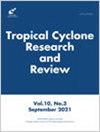Application of stream function in tracking a quasi-closed circulation and its characteristics in developing and non-developing tropical cyclones over the North Indian Ocean
IF 4.1
4区 地球科学
Q3 METEOROLOGY & ATMOSPHERIC SCIENCES
引用次数: 0
Abstract
A precise understanding and prediction of tropical cyclone (TC) genesis remains one of the fundamental objectives for the meteorological community. Monitoring would be much easier if we could anticipate in advance the regions where a TC would form. In this study, we considered 8 cases each of developing and non-developing TCs over the North Indian Ocean (NIO). We found that the stream function averaging over a layer (850-500 hPa) can effectively identify the quasi closed circulation (QCC) before the low-pressure area (LPA) formation. Based on this, we designed an algorithm to track the QCC. The day after an LPA the negative stream-function value at the center of QCC gradually increases in all developing cases. Whereas, in non-developing cases, the negative stream function values are comparatively smaller and remain steady. The total precipitable water within the QCC for developing cases gradually increased on the day of the LPA and persisted until the day of depression. A strong QCC can trap and enhance the availability of moisture through vertical moisture flux transport from the surface in developing lows. However, in non-developing lows, a feeble QCC can only trap moisture at the initial stage but fails to sufficiently moisten the mid-levels. We applied machine learning to identify the threshold values for the stream function and total precipitable water to find the potential of the QCC to become a depression. We tested an algorithm for pre and post monsoon seasons during 2020–2022. The algorithm successfully detected many vortices 5–7 days before the formation of a depression, and it identified depressions 3–4 days in advance. As the thresholds are obtained by machine learning method from the training data, this algorithm could be applied to other basins. This advances our knowledge of the TC origin and aids in its early monitoring.
流函数在北印度洋发展中和非发展中热带气旋准闭合环流跟踪中的应用及其特征
对热带气旋成因的准确认识和预测仍然是气象界的基本目标之一。如果我们能够提前预测可能形成TC的地区,监测就会容易得多。在本研究中,我们考虑了北印度洋(NIO)上发展中和非发展中tc各8例。研究发现,850 ~ 500 hPa的平均层流函数能有效识别低压区形成前的准闭合环流。在此基础上,设计了一种QCC跟踪算法。在LPA后的第二天,所有发展中的病例QCC中心的负流函数值逐渐增加。然而,在非发展情况下,负流函数值相对较小并保持稳定。发展中病例QCC内总可降水量在低气压当天逐渐增加,并持续到低气压当天。在低气压发展过程中,强QCC可以通过地表垂直的水汽通量输送来捕获和增强水汽的有效性。然而,在不发展的低气压中,微弱的QCC只能在初始阶段捕获水分,而不能充分滋润中层。我们应用机器学习来识别流函数和总可降水量的阈值,以发现QCC成为洼地的潜力。我们测试了2020-2022年季风前后季节的算法。该算法在低压形成前5-7天成功检测到许多涡旋,并提前3-4天识别出低压。由于阈值是通过机器学习方法从训练数据中获得的,因此该算法可以应用于其他流域。这提高了我们对TC起源的认识,并有助于其早期监测。
本文章由计算机程序翻译,如有差异,请以英文原文为准。
求助全文
约1分钟内获得全文
求助全文
来源期刊

Tropical Cyclone Research and Review
METEOROLOGY & ATMOSPHERIC SCIENCES-
CiteScore
4.60
自引率
3.40%
发文量
184
审稿时长
30 weeks
期刊介绍:
Tropical Cyclone Research and Review is an international journal focusing on tropical cyclone monitoring, forecasting, and research as well as associated hydrological effects and disaster risk reduction. This journal is edited and published by the ESCAP/WMO Typhoon Committee (TC) and the Shanghai Typhoon Institute of the China Meteorology Administration (STI/CMA). Contributions from all tropical cyclone basins are welcome.
Scope of the journal includes:
• Reviews of tropical cyclones exhibiting unusual characteristics or behavior or resulting in disastrous impacts on Typhoon Committee Members and other regional WMO bodies
• Advances in applied and basic tropical cyclone research or technology to improve tropical cyclone forecasts and warnings
• Basic theoretical studies of tropical cyclones
• Event reports, compelling images, and topic review reports of tropical cyclones
• Impacts, risk assessments, and risk management techniques related to tropical cyclones
 求助内容:
求助内容: 应助结果提醒方式:
应助结果提醒方式:


